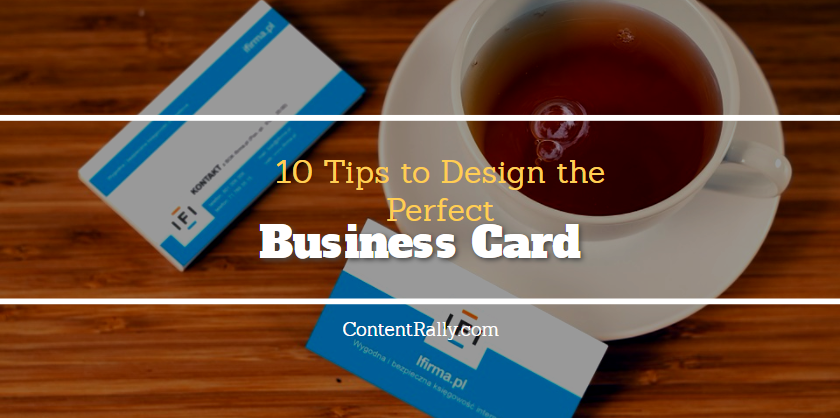Tag: Business Card

How to Design a Killer Business Card
Have you ever attended an important business meeting and you didn’t carry your business card to give out? Well, in this day and age, it’s important to carry with you some form of promotional material. Also, you want to put your best foot forward with the first chance you get. Here are some business card design tips to put you ahead of the game. Different Ways To Design A Killer Business Card For Your Business Awareness There are multiple ways you can use a killer business card for your business awareness. Some of them are as follows 1. Consider Your Audience: Your target market should always come first. Besides, they are the source of your business revenues. Without them, your business will close its doors. Among the questions you should ask yourself include: Who is your target audience? What will capture their attention? From the questions, you can see that they are customer-oriented. This means when coming up with the business card design, you should always have your consumer in mind. Otherwise, what’s the point? 2. The Text: The main aim of a business card is to market your services or products. Therefore, you need to relay the message as clearly as possible. With such limited space on the card, you need to be brief and straight to the point. You want to include contact details, the business logo and the message. Also, you want to position the text where the customer can see it. This means keeping the text far from the edges. The text should also be legible in order to convey the message without any error. You can also include a QR barcode on the card to link the card with various online platforms you’ve already set up. 3. The Colors and Overall Design: If you’re not tech savvy, you might want to get a pro-designer to put all your thoughts together in a creative design. One of the mistakes many people make is to use different colors from the company’s colors. This creates confusion on the consumer’s side. Therefore, maintain the company’s colors on the card. The company’s logo is also important to put a face to the company. For the logo, ensure you use high definition photos. Don’t go for pixelated images. 4. Focus on the Finish: This is where quality printing services come in hand. You might have the best design, but if the printing is done by an amateur, you risk looking like an amateur yourself. Apart from this, consider this: The thickness of the paper – Use a deluxe business card with a colored layer. It might be expensive, but you’ll get a professional look. What’s more, these cards are more durable. Also, when choosing a colored layer, keep in mind the company’s colors. The cut – Many people go for the rectangular cuts, but don’t you go for rounded corners? Rounded corners give your card character and uniqueness. Remember you’re in a competition and you have to get it right in everything lest you come in second. Embossing – Embossing your card introduces a 3D effect. This means it will raise certain areas of the design. Spot UV – This technique is used to varnish parts of the card to create a richer look on the card. Foil blocking – As the name suggests, this process involves placing foil on paper. This is done to logos and text, thus giving the card a metallic touch. Summary: Your business card is your marketing ambassador. It carries your brand to places you won’t get to. For this reason, it’s important to stay ahead of the competition by keeping tabs with the latest printing technology. Read Also: Top 8 Benefits Of Professional Business Cards Advance Copier: Printing Quality Business Cards On Your Own Computer
READ MOREDetails
10 Tips to Design the Perfect Business Card
Handing out business cards is a good way to promote your brand and foster personal connections. But, the creation of perfect and memorable cards clearly remains a challenge. Research shows: 88%—or 9 out of 10—of distributed business cards will be thrown out within one week. How to Design the Perfect Business Card So, what makes these tangible objects impressive? A lovely design. The perfect business card doesn’t only present your contact information. It also communicates your brand’s professionalism. So, if you’re interested in making a positive impression, consider the business card design tips below. 1. Adhere to the Principles of Good Design The perfect business card is a visual representation of your brand. It’s a determining factor in whether people trash your card. And, the following elements of good design are important in capturing people’s attention: Alignment and length Color scheme Content hierarchy Typography Kern Layout Tracking White Space 2. Avoid Complexity in Design When designing the perfect business card, you should aim for simplicity. Simplicity in color and contrast to prevent overwhelm. Simplicity in fonts to prevent difficulty in reading. Remember, you want a prospect or customer to reach out to you for help with their needs. And, by avoiding complexity, you make it easy for them to read your contact information, call your number, and partner with you for your services. 3. Provide Key Information Above, we discussed simplicity in design. And, you can keep it simple by only presenting the information required to communicate who you are, what you do, and how to contact you. Details such as: Name Title, role, or function Business name and logo Physical address Telephone number If space allows, for social connections, you can also add virtual information. For instance, you can include: Professional e-mail address Website landing page or blog address One or two professional social media handles QR code 4. Emphasize Benefit and Value You should also take it a step further and emphasize your benefits. In other words, the perfect business card should do two things: Tell (or remind) people about what you can do for them Tell (or remind) people about the value you offer Limit your explanation to a line or two, describing your service, specialization, and value statement. 5. Consider a Nontraditional Shape Can you choose the standard 3.5x2 inch horizontal rectangle/square? Yes. But nowadays, you also have more creative options available. With die-cuts, for example, you can choose from a variety of shapes: Circle Folded Half-Circle Leaf Oval Rounded Corners Single Rounded Corner Slim Vertical 6. Improve Your Card’s Appearance Additionally, you can improve the look and feel of your business card, through imprinting. Again, you have several methods to choose from: CMYK or Four-Color Printing Embossing Debossing Foil Stamping PMS or Pantone Matching System Depending on your chosen imprint, “finishes”—such as lamination, UV, and spot coatings—can also positively enhance your card’s quality and design. 7. Invest in High-Quality Materials Presentation is an important part of designing the perfect business card. And, the quality of your chosen material impacts your brand’s impression. You have a few choices, when choosing your card’s paper, weight, and thickness: regular, plastic, textured, thick, thin. But, high-quality material is a better investment. How do we know? The National Institutes of Health’s research on haptic sensations found: physical touch can influence the impressions and thoughts formed about people and situations. 8. Ensure Branding Consistency What you shouldn’t do, when designing your business card, is display a lack of cohesion in branding. If there are style, color, and typography inconsistencies in your marketing materials, then people will notice. Remember, your brand identity helps customers and prospects recognize your business. And, when consistent, your business cards reinforce your visual elements. 9. Double-Check for Errors and Unreadable Text You want customers to take you seriously. To trust you. So, double-checking your business cards, before printing, is critical. Read, reread, and edit. Search for spelling, punctuation, grammar, layout, and omission mistakes. But, don’t stop there. Also, make sure your business card is readable by: Using at least 8 point fonts Using font colors complementary to its background 10. Beware Printing Specifications When designing the perfect business card, you must ensure optimal printing. Many printers stop at a certain point. So, it’s important to consider the following specifications: Bleed Area. You should include at least a 1/8” bleed area as it eliminates white space during printing. Safe Area. The center of the business card is the safe area, so you want all your readable text and graphics there. Ready to Design Your Card? Now, you're armed with 10 good design tips for creating the perfect business card. Use this Vistaprint coupon code to save on your next order. Will you apply them? If so, you'll have what you need to increase your brand awareness, make a memorable impression, and even attract new clients. Read also: 7 Big Myths About Small Business Growth Tips For Small Businesses To Raise Funds For Their Projects
READ MOREDetails















